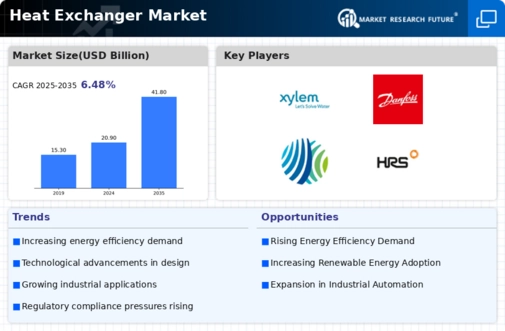Top Industry Leaders in the Heat Exchanger Market

*Disclaimer: List of key companies in no particular order
The global heat exchanger market is characterized by a dynamic and fragmented landscape, featuring a diverse array of established players and emerging companies actively competing for market share. This competitive scenario is propelled by various factors, including a growing demand for energy-efficient solutions, increasingly stringent environmental regulations, and the upsurge of industrialization in developing economies. This combination of drivers presents both challenges and opportunities for participants in the market.
Key Player Strategies: The competitive strategies employed by key players such as Alfa Laval AB (Sweden), Kelvion Holdings Gmbh (Germany), Southern Heat Exchanger (U.S.), Danfoss A/S (Denmark), SPX Corporation (U.S.), Xylem Inc. (U.S.), API Heat Transfer Inc. (U.S.), Gunter AG & Co. KG (Germany), Sierra S.p.A (Italy), Hamon & Cie International SA (Belgium), Koch Heat Transfer Company (U.S.), Hughes Anderson Heat Exchangers (U.S.), and others are pivotal in navigating this landscape.
-
Product Innovation: Companies are significantly investing in research and development (R&D) to create novel and improved heat exchanger designs, enhancing efficiency, performance, and durability. This emphasis on innovation is crucial for meeting emerging market needs and maintaining a competitive edge. -
Expansion: Established players are expanding their geographic footprint through mergers, acquisitions, and organic growth strategies. This strategic expansion enables them to penetrate new markets and customer segments, thereby bolstering their market share and global presence. -
Strategic Partnerships: Collaborations have become more prevalent in the heat exchanger market. Companies are forming partnerships with other organizations, including research institutions and technology providers, to harness complementary expertise and resources. This collaborative approach accelerates innovation, facilitates the development of new technologies, and provides access to untapped markets. -
Focus on Sustainability: Environmental concerns are a driving force behind the demand for sustainable and eco-friendly heat exchangers. Companies are responding by developing products with lower environmental impact, incorporating recyclable materials, and enhancing energy efficiency. -
Digitalization: The integration of digital technologies such as data analytics and artificial intelligence (AI) is reshaping the heat exchanger market. Companies are leveraging these technologies to optimize operations, improve design processes, and enhance customer service.
Factors for Market Share Analysis: In evaluating market share within the heat exchanger market, several critical factors come into play:
-
Product Portfolio: The breadth and depth of a company's product portfolio are significant determinants of market share. Offering a diverse range of products catering to various applications and industries allows companies to capture a larger market segment. -
Geographic Reach: Companies with a robust presence in major global markets typically enjoy a larger market share. Expanding into new and emerging markets further contributes to market share growth. -
Brand Reputation: A robust brand reputation built on qualities such as quality, reliability, and customer service can attract customers and result in a larger market share. -
Innovation Leadership: Companies recognized for their innovative capabilities and leadership in developing new technologies often secure a higher market share. -
Financial Performance: Demonstrating strong financial performance signifies a company's stability and ability to invest in growth initiatives, contributing to a larger market share.
New and Emerging Companies: A wave of new and emerging companies is entering the heat exchanger market, bringing fresh ideas and innovative technologies. These companies often focus on niche markets or develop disruptive technologies with the potential to reshape the industry. Their presence is compelling established players to adapt and innovate to maintain their market positions.
Overall Competitive Scenario: The competitive landscape in the heat exchanger market is anticipated to remain intense in the foreseeable future. Established players are poised to continue dominating the market, but new and emerging companies are expected to gain traction by offering differentiated products and solutions. The market is likely to witness mergers and acquisitions as companies strive to expand their product portfolios and geographic reach. Additionally, technological advancements and an increasing focus on sustainability will continue to shape the competitive landscape.
In Conclusion: The heat exchanger market is a dynamic and competitive space with substantial growth potential. Companies that can adapt to evolving market dynamics, innovate effectively, and prioritize sustainability are well-positioned to thrive in this competitive environment.
Industry Developments and Latest Updates:
-
Alfa Laval AB (Sweden): In October 2023, Alfa Laval launched the next generation of its plate heat exchangers for the dairy industry, offering improved performance and hygiene. -
Kelvion Holdings Gmbh (Germany): In December 2023, Kelvion announced the acquisition of a U.S.-based manufacturer of shell and tube heat exchangers, expanding its product portfolio and market reach. -
Southern Heat Exchanger (U.S.): In August 2023, Southern Heat Exchanger invested in research and development of advanced materials for its heat exchangers to improve efficiency and durability. -
Danfoss A/S (Denmark): In December 2023, Danfoss partnered with a university to develop next-generation heat exchangers for electric vehicles.

